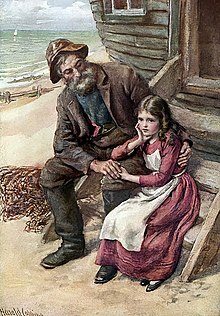Harold Copping
Harold Copping (born August 25, 1863 in Camden Town , London , England , United Kingdom ; † July 1, 1932 in Shoreham , Kent , England, United Kingdom) was a British painter whose main focus was the illustration of biblical scenes and motifs from Charles- Dickens novels was.
Life
Harold Copping was born in Camden Town in 1863. He grew up in St. Pancras and studied at the Royal Academy of Arts , where he was able to achieve a Landseer Scholarship. It wasn't long before Copping was an established and successful painter. Because of his association with the London Missionary Society , Copping began illustrating biblical scenes early on. In order to be able to paint particularly realistic pictures, he went on study trips to Palestine and Egypt . In 1910, a special edition of the Bible illustrated by Copping ( The Copping Bible ) resulted from the numerous pictures of biblical motifs that Copping had painted. In order to be able to use family members and friends as models for his paintings, Copping had his own stock of costumes and props at home. Reproductions of Coppings' pictures in the form of color lithographs were particularly popular on missions.
The most famous illustration Coppings is the hope of the world ( The Hope of the World ). This picture shows Jesus in the midst of a group of children from different continents of the earth. Copping was under contract with the Religious Tract Society , for which he painted twelve pictures of religious subjects annually until his death. The exclusive contract forbade Copping, who was paid £ 50 per picture, to paint religious subjects for any other organization or publisher. But Copping also illustrated numerous other literary works. This included both novels by Charles Dickens and works based on these by his daughter Mary Angela Dickens . There are also illustrations for magazines. Copping spent his old age in Shoreham, Kent, where he died on July 1, 1932 at the age of 68. He was buried in the church cemetery of St Peter and St Paul in Shoreham.
family
Harold Copping was the second son of the journalist Edward Copping (1829-1904) and his wife Rose Heathilla (1832-1877). Harold Coppings maternal grandfather was the painter John Skinner Prout (1805–1876). His brother Arthur E. Copping was a well-known author, journalist, and traveler. Arthur E. Copping was also a member of the Salvation Army . Harold Copping was married twice. His first marriage to Violet Amy Prout (1865-1894), whom he married in 1888, had three children: Ernest Noel Copping (1889-1988), Romney Copping (1891-1910) and Violet Copping (1891-1892). After his first wife died at the age of 29, Harold Copping remarried in 1897. His second wife was Edith Louise Mothersill (* 1876), who gave birth to two children: Joyce Copping (1901-1934) and John Clarence Copping (1914-1977).
Work and reception
The vast majority of Coppings' pictures were illustrations that were widely used in the form of color lithographs. Of particular note are Coppings' illustrations of biblical scenes, which were published together in the 1910 special edition The Copping Bible . From the many biblical images, customized the Copping, stands the hope of the world ( The Hope of the World produced). Sandy Brewer wrote:
“ The Hope of the World , painted by Harold Copping for the London Missionary Society in 1915, is arguably the most popular picture of Jesus produced in Britain in the twentieth century. It was an iconic image in the Sunday school movement between 1915 and 1960 "
“ The Hope of the World , painted by Harold Copping for the Lonson Missionary Society in 1915, is arguably the most famous picture of Jesus to be painted in Britain in the 20th century. It was an iconic image of Sunday Schools between 1915 and 1960. "
But Coppings reception was not always so positive. This is how James Thorpe wrote in Illustration: the Nineties :
"Harold Copping's work, capable and honest as it was, does not inspire any great enthusiasm; there are so many artists doing illustrations equally satisfactory in literal translation and equally lacking in strong personal individuality. "
“Harold Copping's work, competent and honest as it was, does not inspire great enthusiasm; there are so many artists who did illustrations that are just as satisfying in literal translation and just as lacking in strong personal individuality. "
A study trip to Canada resulted in numerous pictures with watercolors, the so-called Canadian Pictures .
Illustrations
Copping's work also includes numerous other book illustrations, including for:
- The Pilgrim's Progress by John Bunyan
- Westward Ho! by Charles Kingsley
- Little Women by Louisa May Alcott
- A Christmas Carol by Charles Dickens
- Oliver Twist by Charles Dickens
- David Copperfield by Charles Dickens
- writings based on Charles Dickens' works by his daughter Mary Angela Dickens
Copping's work also included illustrations for magazines such as Pearson's Magazine , The Leisure Hour , The Royal Magazine , Little Folks , The Temple Magazine and The Windsor Magazine .
Web links
| personal data | |
|---|---|
| SURNAME | Copping, Harold |
| BRIEF DESCRIPTION | British illustrator |
| DATE OF BIRTH | August 25, 1863 |
| PLACE OF BIRTH | Camden Town , London , England , United Kingdom |
| DATE OF DEATH | July 1, 1932 |
| Place of death | Shoreham , Kent , England, United Kingdom |



